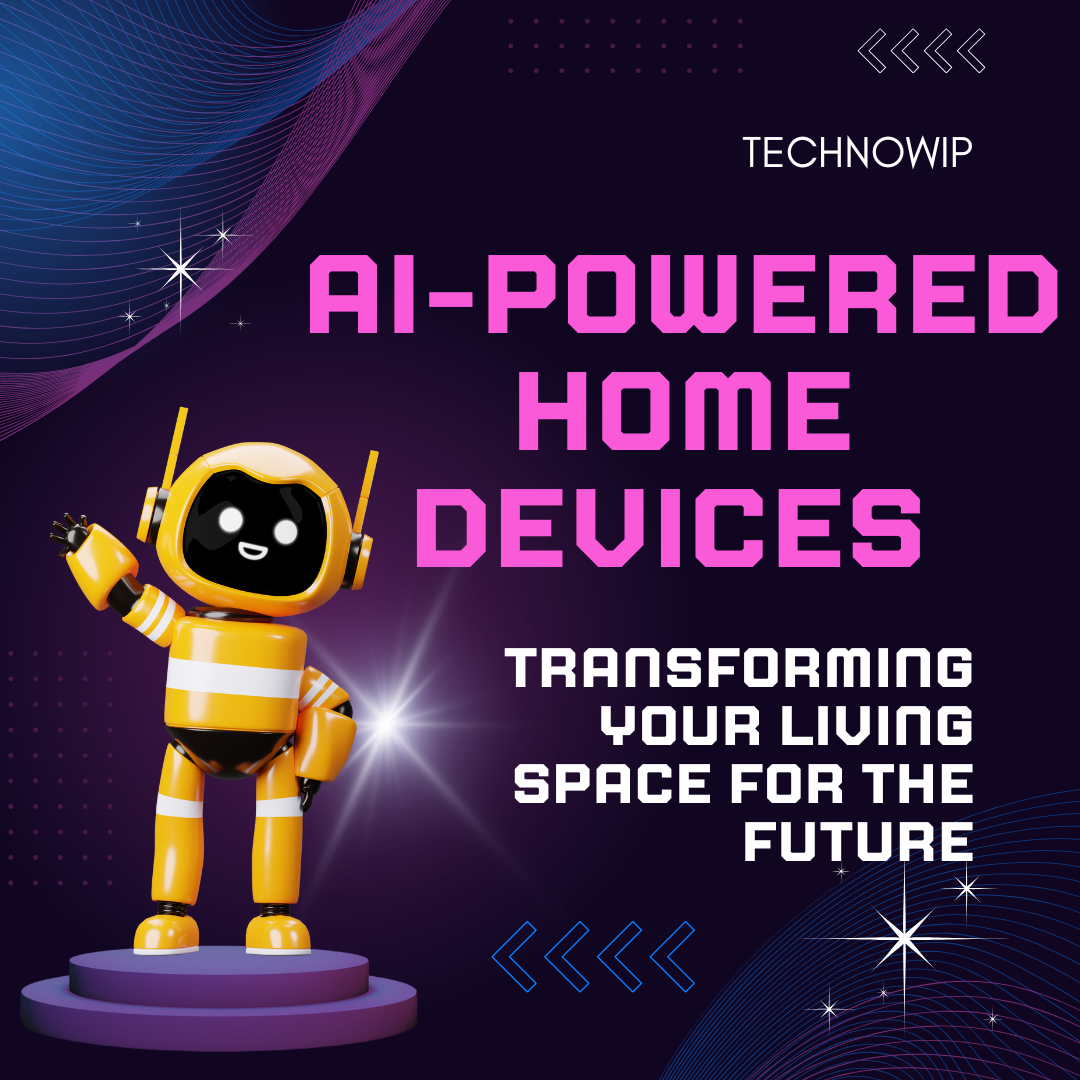Introduction
Artificial Intelligence (AI) has expanded beyond industrial applications into homes. Smart home devices powered by AI are no longer just luxury items for homeowners – they have quickly become essential tools in managing daily life and cutting energy use. We will explore how AI-Powered Home Devices are changing living spaces – making homes safer, more energy-efficient and future proof.
1. What Are AI-Powered Home Devices?
AI-powered home devices are smart systems that utilize machine learning algorithms to automate and optimize household tasks. This tech adapts itself based on patterns or behaviors to offer customized experiences or predict actions; some popular AI devices include:
- Smart thermostats like Nest and Ecobee that adjust temperatures based on user preferences.
- Voice assistants such as Amazon Alexa or Google Assistant that help control other devices.
- AI-powered security cameras which detect unusual activities quickly, alerting homeowners immediately.
2. Why AI Devices Matter in Modern Homes
AI home devices provide more than convenience – they play an invaluable role in energy efficiency as well. A Nest study demonstrated how users saved an average of 10-12% on heating costs and 15% on cooling bills using AI thermostats and lighting systems from Nest’s Iris platform.
- Enhance Security: AI-driven security cameras such as Ring can distinguish between people, animals and moving cars to eliminate false alarms.
- Personalization: Devices like Amazon Echo can adapt to users’ habits over time to offer more relevant recommendations and seamless interactions.
- Automation to Save You Time: AI washing machines and dishwashers can automatically select the most cost-efficient cycle based on load size and dirt level, saving time.
My smart thermostat has made life much simpler for me. It knows exactly when to lower the temperature at night to help me sleep soundly while saving on my energy costs – sometimes, I think this device knows me more intimately than I do myself!
3. Key Use Cases of AI-Powered Devices in Homes
- Voice-Controlled Systems:
- AI assistants like Amazon Alexa or Google Home provide convenient hands-free control over lights, TVs and coffee makers – perfect for multi taskers like us who value our time!
- Statista reports that 41% of U.S. households used voice-controlled AI devices in 2022, reflecting rising consumer interest for smarter living spaces.
- AI-Enabled Cleaning Devices:
- Robot vacuum cleaners like the iRobot Roomba can map your home and optimize cleaning paths over time for efficient results.
- Studies from iRobot revealed users saved about 90 minutes each week on house cleaning with its robotic vacuums.
- Smart Home Security Solutions:
- AI-enhanced cameras and doorbells use facial recognition technology to send instant alerts when they detect unfamiliar faces; companies like Arlo use machine learning algorithms to reduce false alarms by up to 70%, saving their users valuable time while improving home security.
At first I was skeptical about acquiring a robot vacuum; but after using one for only a week it quickly proved itself an indispensable addition. Running automatically and keeping my floors spotlessly cleaned are no longer challenges that need my full attention – it makes life simpler when cleaning becomes an automated experience and manual cleaning becomes something you don’t miss. It was hard going back after having experienced something like that!
4. How AI Devices Are Making Homes More Secure
AI-powered home security systems add an extra layer of protection by:
- Facial Recognition: Some systems can differentiate between family members and unknown visitors, providing real-time alerts.
- Motion Detection: AI cameras can detect specific types of movement and distinguish between harmless activities (like a pet running) and potential threats.
- Proactive Monitoring: Devices can notify homeowners of potential security risks even before an incident occurs, thanks to predictive analytics.
5. The Role of AI in Energy Management
AI helps homeowners manage energy consumption efficiently by:
- Smart Thermostats: Devices like Ecobee use local weather forecasts and household activity patterns to adjust heating or cooling automatically.
- Lighting Control Systems: AI-powered lights turn off when a room is empty, reducing unnecessary energy usage.
- Solar Power Optimization: Some AI systems predict electricity demand and manage solar energy storage to reduce dependency on the grid.
Managing energy consumption used to be a challenge for me. But now, with AI-enabled devices, I no longer have to worry. The thermostat adjusts itself, and the smart lights turn off when I leave the room. It’s like having a personal energy manager.
6. How AI Adapts to Individual Needs
AI-powered devices learn from user behavior and adjust accordingly. For example:
- Smart Fridges can suggest recipes based on the available ingredients.
- Voice Assistants remember your routines, such as morning alarms and coffee schedules, to offer better assistance.
- Customized Entertainment Systems provide content recommendations tailored to your preferences on streaming platforms like Netflix or Spotify.
7. Challenges and Privacy Concerns
Despite the benefits, AI-powered home devices are not without challenges:
- Data Privacy Risks: Many AI devices collect personal data, raising privacy concerns.
- Compatibility Issues: Not all AI devices work seamlessly with each other, making setup difficult.
- Security Vulnerabilities: Smart devices can become targets for hackers if not secured properly.
To mitigate these risks, manufacturers are focusing on encrypted communications and enhanced cybersecurity features.
I’ve had moments where I felt uneasy about how much data my devices collect. But knowing that companies are improving encryption and security features has given me peace of mind. I still take extra steps, like changing passwords regularly.
8. Case Study: Nest Smart Thermostat
The Nest Learning Thermostat is a prime example of AI transforming home living. A study found that it reduced energy consumption by an average of 13.5% across households in the U.S.
Key features include:
- Auto-Schedule Learning: The device learns from your temperature preferences and adjusts automatically.
- Remote Control: You can change settings through a smartphone app, even when away from home.
- Energy History Tracking: Nest provides reports on energy usage, helping users make informed decisions.
9. What the Future Holds for AI-Powered Homes
- In terms of AI powered homes, their future lies with Smart Kitchens (e.g. fridges with artificial intelligence capabilities for meal planning and grocery management) as well as Health Monitoring Systems that track vital signs to provide early medical alerts.
- Fully Automated Cleaning Devices: Future AI robots will not only take care of floors but windows and laundry as well. Advanced Security Systems: AI cameras equipped with facial recognition will combine this information with behavioral analysis for maximum protection.
Imagine coming home and all my lights, temperature controls and oven even set automatically! Not too far off now is reality and I can’t wait to experience it first hand!
1. AI-Integrated Security Systems
AI-integrated security systems have become increasingly popular. These devices use facial recognition and motion sensing technology to differentiate between familiar visitors and potential threats – products like Arlo Pro 5 and Nest Cam IQ Outdoor are indicative of this growing interest, offering smart monitoring solutions with reduced false alarm rates while increasing home protection.
2. AI in Home Energy Management
Consumers are searching for ways to cut energy costs, leading them to adopt smart thermostats like Google Nest that adjust temperature settings based on weather forecasts and user behavior to reduce wasteful energy use. AI systems for managing solar power storage and consumption have also gained prominence as effective methods.
3. Voice-Controlled Home Automation
Voice assistants such as Amazon Alexa, Google Assistant and Mycroft Mark II continue to find new applications within household appliances, offering connectivity and convenience by enabling users to easily control lighting, thermostats and entertainment systems with simple voice command controls.
4. AI-Enhanced Kitchen Appliances
Smart kitchens have become more mainstream, and appliances like the LG InstaView ThinQ range offering customized cooking settings and recipe recommendations are becoming more widely popular with consumers who appreciate these AI features for simplifying meal planning and providing optimal conditions to create various dishes.
5. AI-Powered Pet Care Devices
There has been increasing interest in AI solutions designed to ease pet care, such as CatGenie A.I litter boxes and smart feeders. These automated solutions make pet ownership simpler by learning usage patterns and adapting cleaning cycles accordingly, offering convenience for owners.
6. AI in Smart Air Purification Systems
As homeowners become more conscious about indoor air quality, the popularity of AI-powered air purifiers such as Briiv Pro 2.0 air purifier is rapidly rising. These smart systems monitor and adjust airflow accordingly for optimum conditions through smartphone apps that offer data insights.
7. Personal Robotics for Home Use
As interest in personal robots grows, devices like Enabot Ebo X are showing how robotics will increasingly become integrated with AI systems to offer home management, security and companionship assistance.
8. Standardization and Compatibility with ‘Matter’ Protocol
2024 saw significant advances toward creating uniform smart home standards via Matter’s protocol initiative, designed to make devices from various manufacturers such as smart lights or thermostats compatible across platforms like Apple HomeKit, Google Assistant and Alexa.
9. AI-Driven Routine Automation
AI is increasingly playing an instrumental role in shaping home routines. Voice assistants now allow users to initiate complex routines involving lighting adjustments and music streaming all at the same time through one command; with more intelligent AI updates expected soon. This level of automation could further increase in future.
10. Affordability and Broader Adoption of AI Smart Devices
As smart home technology matures, costs of AI-powered devices such as robot vacuums and smart plugs continue to decrease, increasing adoption rates across households of all kinds – making smart living accessible even to the average household.
10. Conclusion: Is Your Home Ready for the AI Revolution?
AI-enabled home devices have quickly become essential tools in today’s lives, whether that means optimizing energy use with smart thermostats or voice assistants to simplify daily routines; smart homes offer new possibilities as they integrate AI solutions more fully and are accessible. The future holds great promise of advancement as these AI solutions continue to gain ground within homes around us.
AI devices have quickly become not just a tech trend but a lifestyle upgrade. Once you experience their convenience, it becomes hard to imagine returning to traditional methods of managing a home. If you’re still on the fence about investing, start small by purchasing smart plugs or voice assistants – then experience for yourself what a difference this makes in managing a household!
FAQs
What are AI-powered home devices?
AI-enabled home devices are automated systems designed to handle house chores through artificial intelligence.
How do AI home devices improve energy efficiency?
Automated systems optimize energy usage based on patterns and weather forecasts, automatically adapting consumption.
Are AI-powered security systems reliable?
Yes, they provide features such as facial recognition and predictive alerts to increase safety.
What is the role of voice assistants in smart homes?
Voice assistants enable hands-free control of other smart devices.
Do AI devices save time on household chores?
Yes, devices like robot vacuum cleaners and AI washing machines automate routine tasks.
Is my data safe with AI home devices?
Manufacturers implement encryption and security measures.However, users should take extra measures – like changing their password regularly- for their own protection.
Can AI devices work with solar power?
Yes, AI systems optimize solar energy storage to minimize grid dependence..
How much can I save using AI-powered thermostats?
Studies indicate users can save 10-20% in heating and cooling costs by following some effective strategies.
What challenges come with AI home devices?
Challenges related to data privacy include compatibility issues and security threats.
What’s the future of AI in homes?
Future kitchens will likely contain smarter technology such as health monitoring systems and advanced automation tools.

